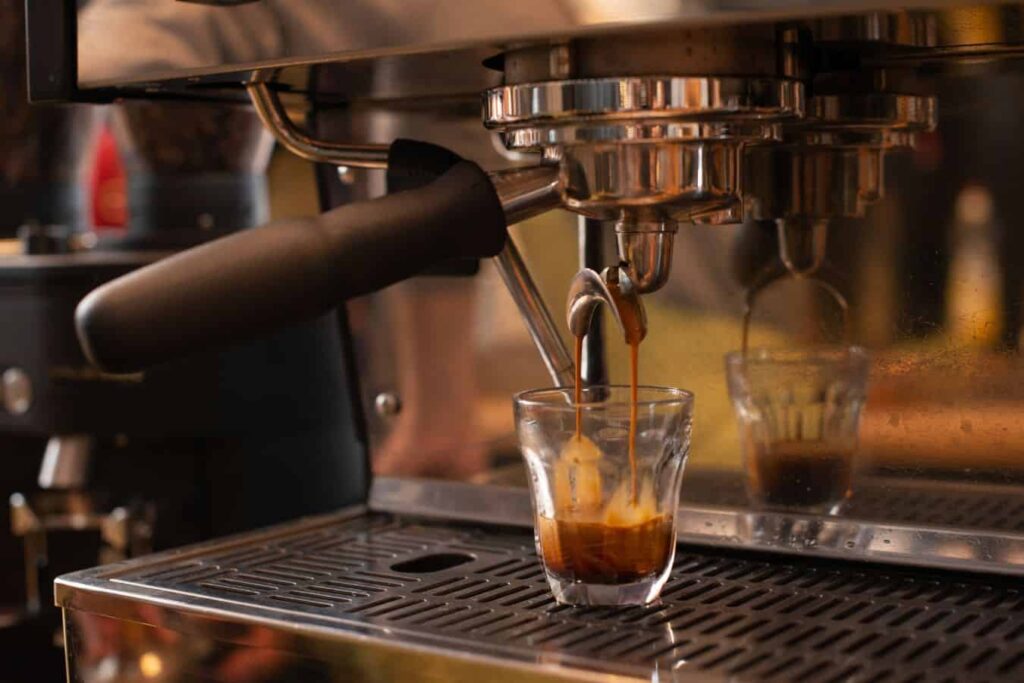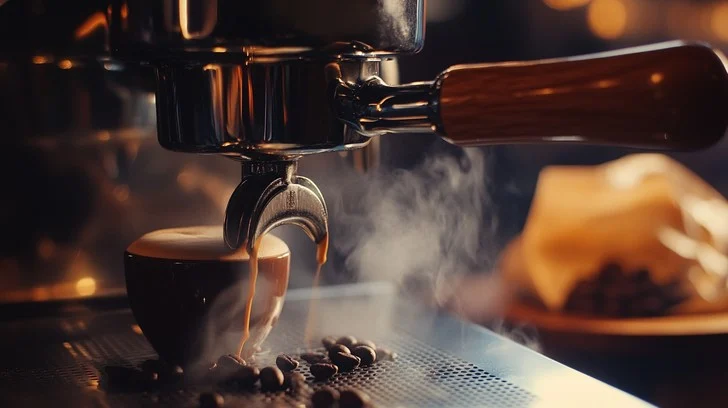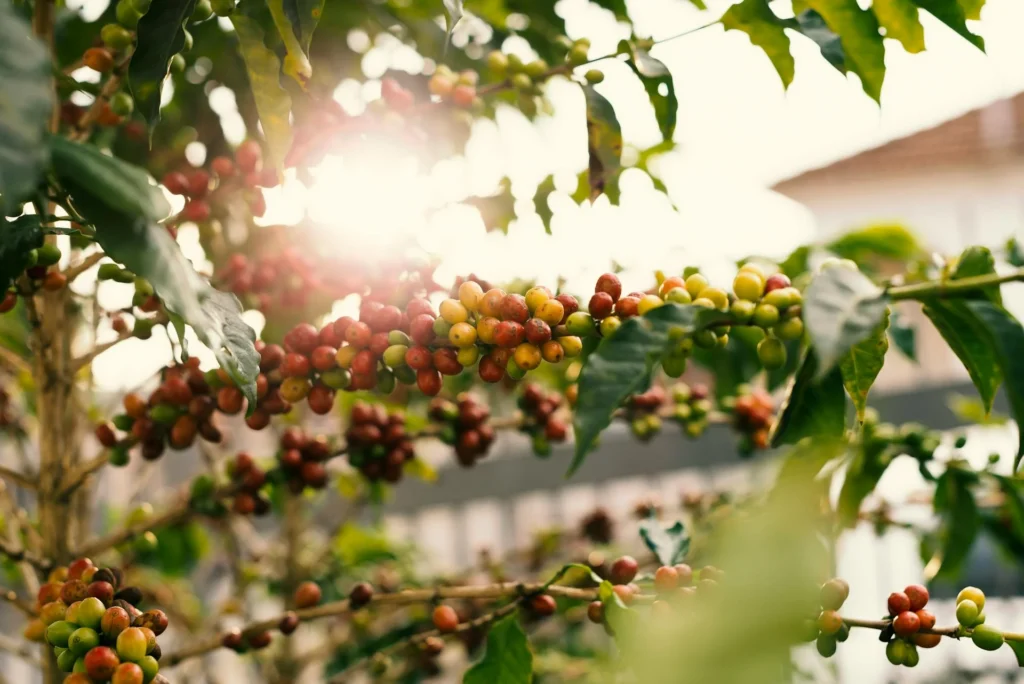If you’re wondering about the ideal pressure for espresso, you’re not alone. Pressure is crucial for extracting the perfect shot of espresso, typically set at around 9 bars. In this article, we will discuss why maintaining the right pressure is important and how it affects the flavor and quality of your espresso.

Key Takeaways
The ideal espresso pressure for brewing is typically around 9 bars, with a recommended range of 7 to 11 bars to avoid over-extraction or weak flavors.
Pressure profiling allows baristas to adjust pressure during the extraction process to enhance specific flavor compounds, leading to a more refined espresso taste.
In addition to pressure, factors such as grind size, water temperature, and regular machine maintenance significantly impact the quality and flavor of espresso.
Understanding Espresso Pressure

Pressure is the driving force behind a perfect espresso shot. It pushes water through the coffee grounds, extracting flavors, oils, and aromas that define the rich taste of espresso. Proper pressure ensures that the extraction process is balanced, avoiding the pitfalls of bitterness or weak flavors that can arise from incorrect pressure settings. Typically, a standard espresso machine operates at about 9 bars of pressure, which means the pressure on the coffee grounds is nine times Earth’s standard atmospheric pressure.
However, achieving the right pressure is a delicate balance. When the pressure exceeds nine bars, the liquid struggles to trickle through the coffee puck, potentially leading to over-extraction and bitter flavors. Conversely, too little pressure can result in a weak and lackluster espresso. This makes finding the ideal pressure crucial for producing a well-balanced and flavorful espresso shot.
The Science Behind Espresso Extraction

The beauty of espresso lies in its rapid brewing process, made possible by the power of pressure. Within seconds, the pressure extract espresso the concentrated flavors and aromas from the coffee grounds, creating a potent and delicious shot. The effectiveness of this extraction is directly linked to the bar pressure applied during brewing, making it essential to understand how this pressure influences the espresso.
Pressure doesn’t just push water through the coffee; it transforms the coffee grounds at a microscopic level. This transformation allows the extraction of individual flavors, oils, and aromas, contributing to the espresso’s complex flavor profile. For instance, higher brew pressures can bring out a nuttier flavor profile, particularly beneficial for lighter roasted coffee. However, exceeding the recommended pressure can lead to an overly dark crema, indicating potential over-extraction and bitterness.
Understanding the dynamic nature of brew pressure is crucial, as it affects the taste, aroma, and texture of the final drink. Mastering the science behind espresso extraction allows you to tailor your brewing process for perfect shots.
Ideal Bar Pressure for Espresso

The quest for the perfect espresso shot often boils down to finding the ideal bar pressure. Generally, the optimal range for espresso extraction is between 7 to 11 bars. Within this range, 9 bars of pressure is widely regarded as the sweet spot for achieving a rich and concentrated espresso shot. This specific pressure balances the forces between water pressure and puck resistance, leading to better extraction and superior flavor.
While 9 bars is considered the industry standard, how many bars are optimal for brewing espresso at higher pressure can yield mixed results. Some baristas prefer slightly lower pressures to avoid the potential for over-extraction and bitterness. Home espresso machines often operate at higher pressures but regulate down to the ideal range for brewing.
Therefore, maintaining the ideal pressure is key to consistently excellent espresso shots.
Pressure Profiling Explained
Pressure profiling is a sophisticated technique that allows baristas to adjust the pressure at different stages of the espresso extraction process. This method can enhance the flavor profile of the espresso by targeting specific flavor compounds. For example, lower pressures during pre-infusion help evenly saturate the coffee grounds, preventing channeling and ensuring uniform extraction.
This technique is particularly beneficial for single-origin coffees, where delicate flavors can be highlighted through precise pressure adjustments. Programming machines to replicate optimal pressure profiles helps baristas achieve consistent, high-quality espresso shots, maximizing each fresh coffee bean’s potential.
Common Issues with Espresso Pressure

Even with the best espresso machine, issues with pressure can arise, leading to subpar espresso shots. The most common problems stem from either too much or too little pressure during the brewing process.
Addressing these issues is key to consistently producing high-quality making espresso.
Too Much Pressure
Using too much pressure in an espresso machine can lead to several problems, including potential damage to the machine itself. High pressure can result in over-extraction, which typically manifests as a bitter flavor and disrupted crema. This happens because the increased pressure forces too many flavor compounds out of the coffee grounds, overwhelming the palate with bitterness.

Additionally, an increase in pressure also prolongs the extraction time, further affecting the quality of the espresso. Carefully monitoring and adjusting pressure settings helps keep them within the optimal range, avoiding these issues.
Too Little Pressure
On the other end of the spectrum, insufficient pressure can lead to weak and underwhelming espresso shots. When the pressure is too low, the espresso flows too quickly, often resulting in a shot that lacks the richness and texture expected from a well-brewed espresso. Common causes of low pressure include overly fine grind, too much coffee in the portafilter, or excessively hard tamping.

Producing a robust flavor and quality crema requires achieving the ideal pressure. By ensuring that the pressure is neither too high nor too low, you can maintain the balance needed for a perfect espresso shot.
Types of Espresso Machines and Their Pressure Capabilities

Espresso machines come in various types, each with different pressure capabilities. Modern espresso machines can range from 1 to 15 bars, providing a wide spectrum of pressure settings for different brewing needs.
Understanding the differences between these machines can help you choose the right one for your specific requirements.
Commercial vs. Home Machines
Commercial espresso machines typically operate at a standard pressure of 9 bars, which is ideal for consistent and high-quality espresso extraction. These machines are designed to handle high volumes and maintain stable pressure throughout the brewing process.
On the other hand, home espresso machines can achieve higher maximum pressures, sometimes up to 19 bars, but often regulate down to the optimal range for brewing. Pump coffee machines, whether commercial or home, are superior for producing the right bar of pressure needed for optimal espresso extraction.
Both types of machines have their advantages, and choosing the right one depends on your specific needs and preferences.


Portable Espresso Makers

Portable espresso machines have become increasingly popular among coffee enthusiasts who want to enjoy quality espresso on the go. These machines can achieve high operating pressures, with some models reaching up to 20 bars. This high pressure capability ensures that portable machines can produce a quality espresso experience comparable to traditional machines.
The convenience and portability of these machines make them an excellent choice for travelers and those who need a compact solution for their espresso needs. Despite their small size, these machines are designed to provide the necessary pressure for a rich and flavorful espresso shot.
How to Adjust Brew Pressure on Your Espresso Machine
Adjusting the brew pressure on your espresso machine can be a game-changer for achieving the perfect shot. Consistency in measuring brew pressure across different machines is crucial for diagnosing extraction problems and ensuring a high-quality espresso. The Group Brew Pressure provides a specific reading at the group head, while Machine Brew Pressure may vary based on machine design.
Effectively measuring brew pressure involves establishing a flow rate, like 2 ounces in 25 seconds, while monitoring the pressure. Machines with vibrating pumps typically don’t allow for easy adjustments without DIY hacks, so understanding your machine’s capabilities and limitations is crucial. If you find that the pressure is too low, adjusting the grind size can help achieve the desired extraction.
Regular calibration and maintenance ensure stable pressure and consistent shot quality in espresso machines. This includes checking and adjusting the pressure settings periodically to match the specific requirements of the coffee being brewed.

Factors Beyond Pressure: Enhancing Your Espresso
While pressure is a critical factor in espresso brewing, other elements such as grind size, water temperature, and maintenance also play significant roles. These factors can greatly influence the quality of your espresso, and understanding how to optimize them can lead to a superior brew.
Grind Size

The grind size of your coffee grounds is crucial for optimal espresso extraction. Pressure emulsifies the oils in the coffee, creating a stable layer of crema and optimizing flavor extraction. Finding the right grind size within the optimal range can significantly impact the taste and richness of your espresso.
Experimenting with different grind sizes can help you discover the perfect balance for your specific espresso machine and coffee beans. Adjusting the grind size allows you to fine-tune the brewing process, achieving a more consistent and flavorful espresso shot.
Water Temperature

Water temperature is another critical factor that affects espresso extraction. It plays a vital role in dissolving flavors and oils from the coffee grounds, influencing the overall balance and taste of the espresso. To avoid under-extraction or over-extraction, the water temperature needs to be within a specific range.
The right water temperature ensures the espresso is brewed with balanced flavors. Too hot or too cold water can disrupt the extraction process, leading to an unbalanced and less enjoyable espresso shot.
Consistency and Maintenance

Consistency and maintenance are vital for achieving similar taste profiles and quality in espresso shots. Regular maintenance of your espresso machine, such as daily backflushing and periodic calibration, ensures that the machine operates at its optimal performance level. This upkeep helps maintain consistent brewing quality and prevents issues that could affect the espresso’s taste and texture.
Adhering to a regular maintenance schedule helps avoid unexpected variations and ensures each cup meets your standards. Consistency in machine care directly translates to consistency in your espresso, making it a crucial aspect of the brewing process.
Summary
Mastering the ideal pressure for espresso is a journey that involves understanding the science behind espresso extraction, recognizing the importance of optimal bar pressure, and learning how to adjust and maintain your espresso machine. By focusing on the right pressure, you can achieve a well-balanced espresso shot that highlights the rich flavors, oils, and aromas extracted from the coffee grounds,,,,,,.
In addition to pressure, factors such as grind size, water temperature, and regular maintenance play significant roles in enhancing your espresso experience. By combining these elements, you can consistently produce high-quality espresso shots that satisfy your taste preferences. Embrace these insights, and elevate your espresso brewing to new heights.
Frequently Asked Questions
What is the ideal pressure for brewing espresso?
The ideal pressure for brewing espresso is around 9 bars, which is considered the industry standard for optimal extraction. Ensuring that pressure is within the 7 to 11 bar range will enhance the quality of your espresso.
How does pressure affect the flavor of espresso?
Pressure significantly impacts espresso flavor by optimizing the extraction of essential oils and aromas from the coffee grounds. Adequate pressure leads to a balanced shot, preventing undesirable bitterness or a weak taste.
What are the common issues caused by too much pressure in espresso machines?
Excess pressure in espresso machines often causes over-extraction, resulting in bitter flavors and disrupted crema, and can potentially damage the machine. It’s crucial to monitor and maintain optimal pressure for quality espresso.
How can I adjust the brew pressure on my espresso machine?
To adjust the brew pressure on your espresso machine, measure the pressure during extraction and establish a flow rate, then modify the grind size and machine settings as needed. Regular maintenance and calibration will also help ensure optimal performance.
Why is regular maintenance important for espresso machines?
Regular maintenance is crucial for espresso machines as it ensures consistent brew quality and optimal performance. This involves routine tasks like backflushing and calibration to prevent flavor and texture issues in the espresso.





